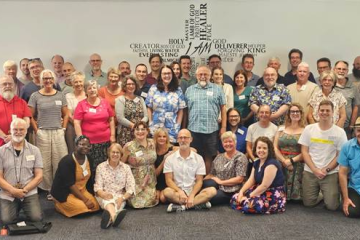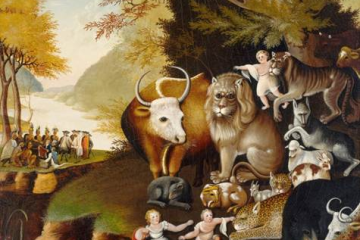I want to start with a little exercise this morning…
If I asked you to complete the line, “No one on their deathbed ever said, “I wish…” how does the line end? (I wish I had spent more time at the office/I wish I’d spent more time at work/I wish I had worked harder?)
(Response) Yes, that is the expression most of us know. Apparently it was popularised by US Senator Paul Tsongas, who, when following a cancer diagnosis decided not to seek re-election, and he attributes it to his friend, lawyer Arnold Zack who wrote to him, “No one on his deathbed ever said, ‘I wish I had spent more time on my business.’”
But I’ve been reading Julia Baird’s recent book bright shining – how grace changes everything and she mentions the work of aged-care chaplain Kerry Egan, her book On Living, and her finding that what preoccupied people in the months before they died was the way “they viewed, and treated, their bodies as problems, or as sources of embarrassment, shame, sin and guilt.… the time wasted spent hating their bodies…abusing it or letting it be abused…until they were so close to leaving it….
Second in intensity to the regret of hating their bodies, says Egan, was ‘the wish of the dying that they had appreciated their bodies in the course of their lives….the feel of the water the first time they wet skinny dipping. The smell of their babies’ heads. The breeze on their skin that time they made love outside.’”
But what people regretted more than anything was that they had not danced enough! Egan writes, “I can’t count the hundreds of times people – more men than women – have closed their eyes and said, when describing [armed forces] dances during World War II, or social dancing at South Carolina beach houses, of long, exuberant nights dancing at roadhouses and discos and barns and wherever else there were bodies and music, ‘If I had only known, I would have danced more.’”
I realise that Egan and Baird are talking about actual dance – about the way we move our bodies to express joy, connection with others, excitement, confidence, tenderness – but I am also thinking about the grace of dance as a theological metaphor for the grace of God – the healing, forgiving, restoring work of God in our broken world. And thinking about Egan’s insight into what people regret and long for at the end of their lives and wondering if what transformed the early church and Jesus disciples – specifically Peter in our reading this morning – what gave them this boldness – was the desire not to regret, not to miss out on, having danced the dance of grace.
In the words of W.H. Auden’s poem, Whitsunday in Kirchstetten (Whitsunday being another name for Pentecost), “what do I know, except what everyone knows – if there when Grace dances, I should dance.”
There are many wonderful images of Grace dancing or Jesus dancing in the works of poets and painters. We often sing Sydney Carter’s hymn, Lord of the Dance, or you may know the medieval carol, Tomorrow will be my dancing day. There is a great coverage of these songs and many paintings by blogger Victoria Emily Jones on her site The Jesus Question, but I was particularly struck by the work of Cosmo Sarson who in 2013 painted this ‘Breakdancing Jesus’ as a 30ft high mural in Bristol. It lasted for 8 years – a lifetime in terms of street art and a world record for that part of Bristol.
In these chapters of Acts, Peter realises that he is there when Grace is dancing…that Grace was dancing in the resurrection of Jesus!
More than any other gospel writer, Luke emphasizes the resurrection as Jesus’ vindication. And here are Peter’s words from Acts 2:24: “God raised him up, having freed him from death, because it was impossible for him to be held in its power.” And from verse 27, quoting Psalm 16, “For you will not abandon my soul to Hades, or let you Holy One experience corruption. You have made known to me the ways of life; you will make me full of gladness with your presence.”
And Peter knows that Grace having danced in the life of Jesus, having danced this extraordinary dance to hell and back, to make known the ways of life, is not done dancing; that Grace continues in our broken world.
And fittingly, the word used for the extraordinary dynamism of grace in this passage is a word whose exact meaning is hard to pin down. It takes the form of healing, in the case of the man born lame who we will focus on next week. It takes the form of forgiveness for those who had rejected and crucified Jesus. We read of this forgiveness in Acts 2:37-39. It is spoken of as ‘salvation’ in verse 12, “There is no other name under heaven given among mortals by which we must be saved.” And it takes the form of reversal of societal norms, as we reflected on last week, in the ongoing healing and feeding, renewing and restoring of our broken lives and communities.
These reversals are highlighted in this passage. The one who was sick is now well. The one who was crucified has been raised. The stone that was rejected has become the cornerstone. In the same way that in our hymn in a few moments, we will sing; the wretch is saved, the lost are found, the blind see. This is the ongoing dance of Grace.
But Grace is not an easy dance to dance. We see this – so very clearly in our world right now. It is a dance of self-giving when our desire is to take. It is a dance of forgiveness when we would seek retribution. It is a dance of openness, of vulnerability, when our instinct is to defend ourselves. Yet this is also a dance of hope and of new life and of joy. And despite the challenge of the dance, we discover that it is the surprising ones, the uneducated and ordinary men, the overlooked women, the hopeless cases, the little children, who pick up its steps most readily.
And this is the case of Peter.
Only a few chapters before, when you consider Luke-Acts as one volume, Peter is cowering in fear before a servant-girl and her friends (Luke 22:54-62). But here in Acts 4:5 he and John face off against, the temple “rulers, elders and scribes…Annas the high priest, Caiphas, John and Alexander, and all who were of the high-priestly family.” This is an extraordinarily uneven contest! All the firepower of priestly authority versus two simple fishermen. Its David and Goliath all over again. Perhaps the rulers, elders and scribes should have heeded that lesson before demanding to know, “By what power or by what name did you [heal this man]?”
But Peter knows that Grace is dancing and he should dance. “Full of the Holy Spirit”, verse 8 says, he tells this extraordinary assembly it is, “by the name of Jesus Christ of Nazareth…whom you crucified,” that this man is healed; that Jesus, the one they rejected has become the ‘cornerstone’, the foundation and shape and direction, for where God’s life is found and how God’s life is experienced.
For Peter and John are evidence of this life! Verse 13, “when they saw the boldness of Peter and John and realised they were uneducated and ordinary men, they were amazed and recognised them as companions of Jesus”.
Are we recognisable as companions of Jesus? As being people who proclaim life in our words and our actions? Are we people whose footsteps and hands and bodies and mouths are dancing the steps of healing and forgiveness and salvation and restoration through our interactions with people in our daily lives? And are we people, who as theologian Willie James Jennings says, in participating in “the concrete liberating actions of God for broken people” find the arrayed forces of social, political, religious power coming for us as well?
Are we people who know what everyone knows – that if there when Grace dances, we should dance?
Or will we, at some stage in our lives, wish that we had danced more?
I found, reading those words, in Julia Baird’s book on grace both convicting and liberating. I don’t want to get to the end of my life and find because I thought I was too overweight or too unattractive or not sporty enough that I didn’t go swimming or take hikes or that I wasted time feeling bad about myself in clothes or photographs; that I didn’t dance more.
And in the same way I don’t want to get to the end of my life and find I did not experience the grace of God that is there in giving rather than in accumulating, that is there in sharing food and friendship with old and new friends, that is there in speaking words of comfort and encouragement, that is there in forgiving and letting go of hurt and moving on, that is there in being part of a community that works together to bring healing and forgiveness and salvation and restoration to a broken world. I want to be someone who learned to dance with Grace.
In May 2001 journalist Giles Brandeth interviewed South African Anglican Archbishop Desmond Tutu. It was a powerful experience for Brandeth, for Desmond Tutu was having treatment for prostate cancer and Brandeth was told this might be his last interview. What would Tutu want to talk about? Perhaps about the amazing transformation in the politics of his country, in which he had played a leading role. No. Here’s what he told Brandeth: “If this is going to be my last interview, I am glad we are not going to talk about politics. Let us talk about prayer and adoration, about faith – and hope – and forgiveness.”
There are many pictures – perhaps this will not surprise you – of Archbishop Desmond Tutu dancing. This is one of my favourites – at a Pro-Tibet rally in 2008 – he did make a good recovery from that cancer treatment. But also this one – 84 years of age teaching the Dalai Lama how to bust a move – at a Tibetan Children’s School. Or even this one – two months before his death – at his 90th birthday celebration in church in Cape Town – still dancing in a wheelchair as his wife Leah dances beside him.
Let us be people of prayer and adoration, of faith – of hope – and forgiveness, people of healing and salvation and restoration. Let us be people who dance with Grace.





